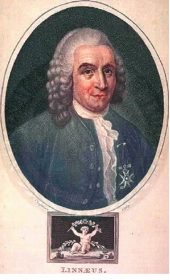Carolus Linnaeus, the originator of the system of classification of animals and plants that we still use today, was eventually ennobled in 1757 as Carl von Linné. He was born in southern Sweden during the first decade of the 18th century, a time when knowledge of exotic faunas and floras was beginning to seep into Europe as a result of mercantile voyages to remote parts of the world. Educated in medicine at Lund and Uppsala universities, he was steered early on into the study of botany by the Uppsala professor Olof Celsius.
From 1732 onward, Linneus undertook a series of botanical surveys in different parts of Scandinavia and also visited other parts of Europe, notably France, England, and Holland, where he completed his medical studies in 1735. That year, he also published the first edition of his great classification of nature, Systema Naturae, Sive Regna Tria Naturae, Systemice Proposita per Classes, Ordines, Genera et Species. Back in Sweden, in 1739 Linnaeus participated in the founding of the Royal Swedish Academy of Science, in 1741 he assumed the chair of medicine at Uppsala, and in 1742 he switched that for the chair of botany. Over the next decade or so, he published a series of strictly botanical volumes while at the same time devoting himself to the enlargement and refinement of his encyclopedic Systema Naturae. This latter work eventually became his primary preoccupation and the source of increasing international fame, going through 12 editions before his death in 1778. For the purposes of priority in animal taxonomy, the definitive edition of Systema Naturae is taken to be the 10th, published in 1758. By international agreement, the correct name for any species is the one given it by Linnaeus in 1758 or the first one to be validly published after that date.
 From an anthropological point of view, the most important aspect of the 10th edition is that in it Linnaeus included the species name Homo sapiens, within which he formally recognized four “varieties”: “Americanus,” “Europaeus,” “Asiaticus,” and “Afer” (essentially African). This was also the edition in which he changed the name of his class Quadrupedia to Mammalia and introduced the order primates to unite the genera Homo, Simia, Lemur, and Vespertilio (bats). Linnaeus’s notion of Homo still owed something to the ancient idea of the Great Chain of Being and included certain forms more appropriate to a bestiary, but it did group our own species in the same genus as Homo troglodytes, a construction essentially based on the orangutan. In classifying H. sapiens in the same genus as an ape, and this genus together with the lemurs and monkeys, Linnaeus took the bull by the horns and included humans as an integral component of nature.
From an anthropological point of view, the most important aspect of the 10th edition is that in it Linnaeus included the species name Homo sapiens, within which he formally recognized four “varieties”: “Americanus,” “Europaeus,” “Asiaticus,” and “Afer” (essentially African). This was also the edition in which he changed the name of his class Quadrupedia to Mammalia and introduced the order primates to unite the genera Homo, Simia, Lemur, and Vespertilio (bats). Linnaeus’s notion of Homo still owed something to the ancient idea of the Great Chain of Being and included certain forms more appropriate to a bestiary, but it did group our own species in the same genus as Homo troglodytes, a construction essentially based on the orangutan. In classifying H. sapiens in the same genus as an ape, and this genus together with the lemurs and monkeys, Linnaeus took the bull by the horns and included humans as an integral component of nature.
The roots of Linnaeus’s system of classification go back to Aristotelianism and medieval scholastic logic with their entailed concepts of essence, but in practice the Linnaean approach has proved to be remarkably adaptable to changing biological perspectives. The 10th edition was published a century before Darwin’s On the Origin of Species introduced the notion of evolution into biological classification. But with a judicious expansion of rank levels, Linnaeus’s inclusive classificatory hierarchy, whereby species are grouped into increasingly comprehensive sets (for example, genera, orders, classes), actually fits the branching pattern of evolutionary descent quite well and is certainly preferable as a practical matter to the alternatives offered.
References:
- Blunt, W. (1971). The compleat naturalist: A life of Linnaeus. New York: Viking.
- Frangsmyr, T. (Ed.). (1984). Linnaeus: The man and his work. Berkeley: University of California Press.
- Jackson, B. D. (1923). Linnaeus. London: Witherby.

